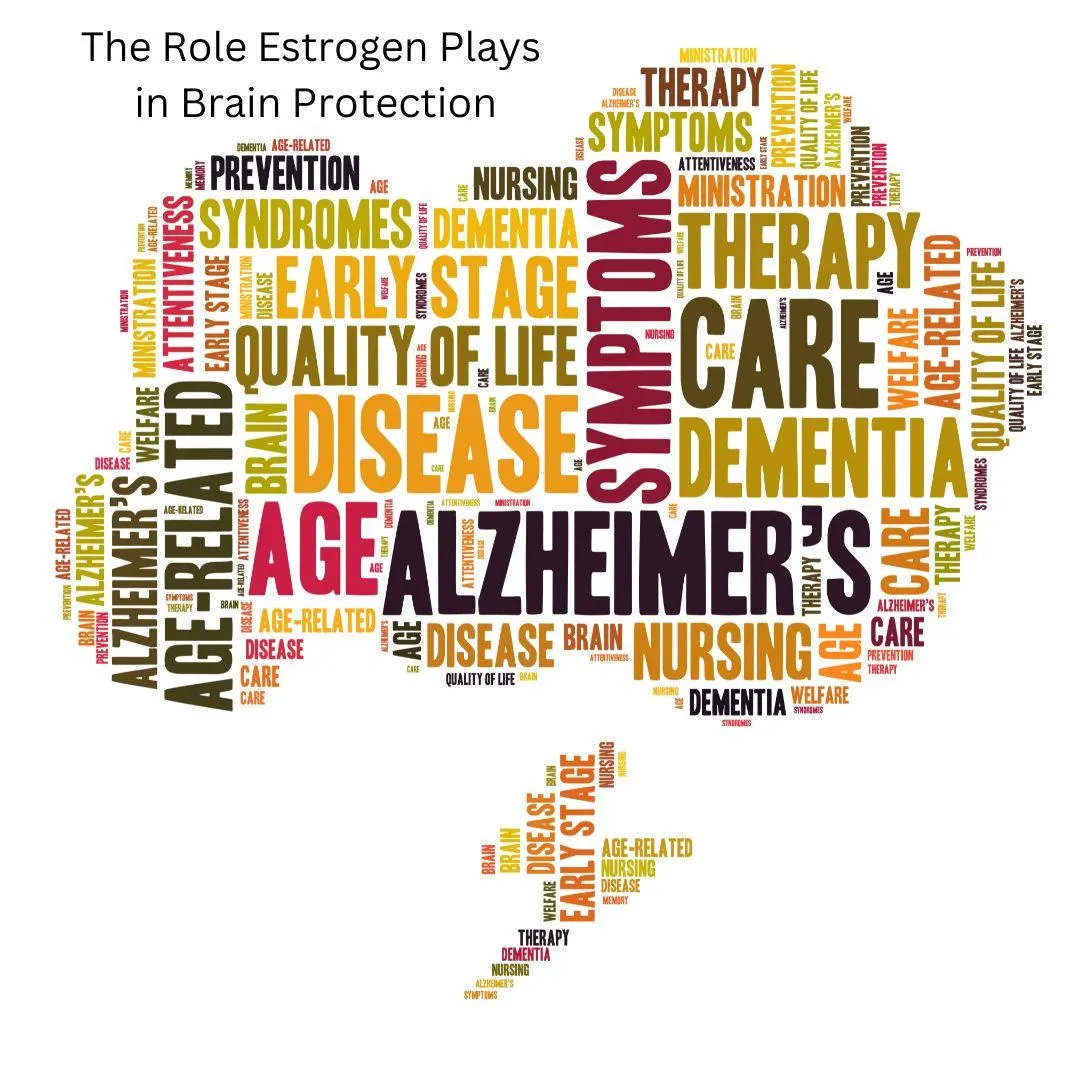*Open to Florida Residents
Blog
Blog

Alzheimer's, the role Estrogen plays in brain protection
The statistics paint a sober picture. Projections indicate that by 2050, a staggering 13.8 million Americans will be affected with Alzheimer’s disease, and of this number, over 9 million will be women. Alzheimer’s stands as the predominant form of dementia, and alarmingly, it is the sole affliction among the nation’s top 10 leading causes of death that lacks highly effective pharmaceutical treatment. Unfolding gradually over the years, Alzheimer’s mercilessly strips its victims of integral aspects of their identity-memories, independence, the sense of love and connection with family and friends, and even basic language for communication. In moments of clarity, those afflicted sense these elements slipping away, marking a slow and agonizing decline that is incredibly challenging for both the individual and their loved ones.
While Alzheimer’s affects both genders, its diagnosis occurs twice as frequently in women compared to men. This blog delves into a closer examination of Alzheimer’s shedding light on the distinctive factors that predispose women to the disease more frequently than men. These factors encircle the intricate interplay of brain structure and function, the impact of stress and cortisol on the female brain, and the enduring influence of sex hormones throughout a woman’s lifetime.
So, summarize the actual definition of Alzheimer’s disease, it is classified as a progressive neurodegenerative disorder characterized clinically by dementia and pathologically by the emergence of excessive plaques, neural pruning, synapse loss, and eventual neuronal death. Neural pruning, a natural process aimed at enhancing the efficiency of the brain by eliminating unnecessary connections between neurons, becomes dysregulated in Alzheimer's. This dysregulation is often fueled by factors such as inflammation, suboptimal levels of hormones and neurotransmitters crucial for synaptic communication and exposure to toxic substances.
Women normally have a longer life expectancy compared to men which may explain the higher prevalence of Alzheimer’s in women, plus the distinct biological differences in brain structure and function, variations in the immune system, a greater tendency for depression and sleep disorders, responses to psychosocial stress, and hormonal changes over lifetime.
The influence of estrogen significantly contributes to sex differences observed in Alzheimer’s. As women undergo perimenopause and menopause, they may encounter challenges related to short-term memory, executive function, and verbal abilities. While these symptoms are often temporary during the menopausal transition, a strong association exists between Alzheimer's development and the decline of steroid hormones as women age.
Estrogen, progesterone, and androgens play pivotal roles in shaping the behavior of neurons and glial cells. Specifically, 17 beta-estradiol emerges as a protective factor against Alzheimer’s impacting neuronal and glial plasticity in women. The positive effects of 17-beta-estradiol contribute to maintaining a conducive environment for neuronal function through the support of glial cells.
Both men and women benefit from the neuroprotective effects of estrogen, but men may maintain higher brain levels of estrogen later in life due to aromatase conversion of testosterone to estrogen. In both sexes the brain synthesizes estrogen extra-gonadally through aromatase activity. In men, where circulating estrogen from androgens is the primary source of estrogens in the brain. This differs in premenopausal women, were brain estrogens levels come from local production as well as peripheral estrogens produced in the ovaries, freely diffusing into the brain. Menopausal women, having lower peripheral estrogen production and reduced circulating testosterone levels compared to men, face limitations in generating significant brain estrogen through aromatase activity.
Steroid hormones play a vital role in neuronal excitability, contributing to neuroplasticity. In women, estradiol shapes memory circuits by promoting hippocampal activity. Estradiol may boost dopamine activity, neurogenesis, and cell proliferation while reducing cell death and inflammation across the brain and nervous system. This decreased susceptibility to inflammation adds resilience against development of Alzheimer’s.
Stress is unavoidable in this day and time; with the added journey of menopause, it can seem overwhelming. We must address certain modifiable risk factors that specifically contribute to the development of Alzheimer’s. A good starting point is monitoring our hormone levels and assessing salivary cortisol. Establishing baseline values at key stages in a woman’s life can provide guidance as she navigates the hormonal transition from pre-menopause to menopause.
Researchers at the University of Toronto have been able affirm the benefits of postmenopausal estradiol in showing significant reduction in the risk of Alzheimer’s. They also have shown the advantages of progesterone and testosterone in neuronal protection. The researchers also highlighted that initiation of treatment was pivotal in benefits in preventing Alzheimer makers. It was suggested that neurons of the brain must be in a healthy state to respond positively to the hormonal treatments. Once the neurons' cells undergo degradation the response to HRT is negative.
As women it is imperative that we take action to protect not only our body but also our minds. Understanding the unique impact that hormones play in our brain can potentially give us avenues for prevention from the worst thieves of our mind, memory and thoughts, Alzheimer’s.

Alzheimer's, the role Estrogen plays in brain protection
The statistics paint a sober picture. Projections indicate that by 2050, a staggering 13.8 million Americans will be affected with Alzheimer’s disease, and of this number, over 9 million will be women. Alzheimer’s stands as the predominant form of dementia, and alarmingly, it is the sole affliction among the nation’s top 10 leading causes of death that lacks highly effective pharmaceutical treatment. Unfolding gradually over the years, Alzheimer’s mercilessly strips its victims of integral aspects of their identity-memories, independence, the sense of love and connection with family and friends, and even basic language for communication. In moments of clarity, those afflicted sense these elements slipping away, marking a slow and agonizing decline that is incredibly challenging for both the individual and their loved ones.
While Alzheimer’s affects both genders, its diagnosis occurs twice as frequently in women compared to men. This blog delves into a closer examination of Alzheimer’s shedding light on the distinctive factors that predispose women to the disease more frequently than men. These factors encircle the intricate interplay of brain structure and function, the impact of stress and cortisol on the female brain, and the enduring influence of sex hormones throughout a woman’s lifetime.
So, summarize the actual definition of Alzheimer’s disease, it is classified as a progressive neurodegenerative disorder characterized clinically by dementia and pathologically by the emergence of excessive plaques, neural pruning, synapse loss, and eventual neuronal death. Neural pruning, a natural process aimed at enhancing the efficiency of the brain by eliminating unnecessary connections between neurons, becomes dysregulated in Alzheimer's. This dysregulation is often fueled by factors such as inflammation, suboptimal levels of hormones and neurotransmitters crucial for synaptic communication and exposure to toxic substances.
Women normally have a longer life expectancy compared to men which may explain the higher prevalence of Alzheimer’s in women, plus the distinct biological differences in brain structure and function, variations in the immune system, a greater tendency for depression and sleep disorders, responses to psychosocial stress, and hormonal changes over lifetime.
The influence of estrogen significantly contributes to sex differences observed in Alzheimer’s. As women undergo perimenopause and menopause, they may encounter challenges related to short-term memory, executive function, and verbal abilities. While these symptoms are often temporary during the menopausal transition, a strong association exists between Alzheimer's development and the decline of steroid hormones as women age.
Estrogen, progesterone, and androgens play pivotal roles in shaping the behavior of neurons and glial cells. Specifically, 17 beta-estradiol emerges as a protective factor against Alzheimer’s impacting neuronal and glial plasticity in women. The positive effects of 17-beta-estradiol contribute to maintaining a conducive environment for neuronal function through the support of glial cells.
Both men and women benefit from the neuroprotective effects of estrogen, but men may maintain higher brain levels of estrogen later in life due to aromatase conversion of testosterone to estrogen. In both sexes the brain synthesizes estrogen extra-gonadally through aromatase activity. In men, where circulating estrogen from androgens is the primary source of estrogens in the brain. This differs in premenopausal women, were brain estrogens levels come from local production as well as peripheral estrogens produced in the ovaries, freely diffusing into the brain. Menopausal women, having lower peripheral estrogen production and reduced circulating testosterone levels compared to men, face limitations in generating significant brain estrogen through aromatase activity.
Steroid hormones play a vital role in neuronal excitability, contributing to neuroplasticity. In women, estradiol shapes memory circuits by promoting hippocampal activity. Estradiol may boost dopamine activity, neurogenesis, and cell proliferation while reducing cell death and inflammation across the brain and nervous system. This decreased susceptibility to inflammation adds resilience against development of Alzheimer’s.
Stress is unavoidable in this day and time; with the added journey of menopause, it can seem overwhelming. We must address certain modifiable risk factors that specifically contribute to the development of Alzheimer’s. A good starting point is monitoring our hormone levels and assessing salivary cortisol. Establishing baseline values at key stages in a woman’s life can provide guidance as she navigates the hormonal transition from pre-menopause to menopause.
Researchers at the University of Toronto have been able affirm the benefits of postmenopausal estradiol in showing significant reduction in the risk of Alzheimer’s. They also have shown the advantages of progesterone and testosterone in neuronal protection. The researchers also highlighted that initiation of treatment was pivotal in benefits in preventing Alzheimer makers. It was suggested that neurons of the brain must be in a healthy state to respond positively to the hormonal treatments. Once the neurons' cells undergo degradation the response to HRT is negative.
As women it is imperative that we take action to protect not only our body but also our minds. Understanding the unique impact that hormones play in our brain can potentially give us avenues for prevention from the worst thieves of our mind, memory and thoughts, Alzheimer’s.
Let me help you achieve your goals.
Disclaimer: We understand that every individual's experience is unique and results may vary depending on various factors, such as attitude, adaptability, personal history, and overall health. For your safety and well-being, we highly recommend consulting your physician before beginning any program. At Elite Sexual Hormone Health, we do not diagnose, treat, or prescribe any medical or psychological disorders. We urge you to seek the care of a qualified physician or psychotherapist if you suffer from any psychological or medical disorder. Thank you for choosing Elite Sexual Hormone Health as your partner in your journey towards wellness.
© 2025, Elite Sexual Hormone Health. All rights reserved.
Privacy Policy | Terms of Service | Disclaimer
© 2025, Elite Sexual Hormone Health. All rights reserved.
Website by Hypnotherapy Accelerator





